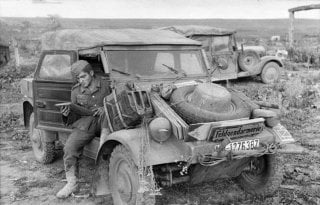Meet the Kübelwagen: The Nazi Germany's Very Own Military Jeep (Thanks to Porsche)
Designed by Porsche and built by Volkswagen.
Needing a lightweight off-road vehicle to equip the German Army, Adolf Hitler asked Ferdinand Porsche to design a military transport car—the Kübelwagen, or the German Jeep.
Origins
Before the Second World War, the German Wehrmacht needed a car to transport troops to and fro on the battlefield. The design had to be light-weight and had to have excellent off-road performance for navigating European battlefields. It also had to cope with a wide range of weather conditions—cold European winters, as well as hot, dusty climates like in North Africa or Italy.
Design
Though the Kübelwagen (“tub car” or “bucket car”) was not particularly powerful, nor heavy, it was quite nimble. The Kübelwagen was based on the Volkswagen Beetle design, though the final model was heavily modified.
Originally the Kübelwagen had been outfitted with a modest 985 cc, 23.5 horsepower engine. The engine was located in the rear of the Kübelwagen’s frame and was air-cooled. This had two advantages. Since the engine was at the rear, it was better protected from bullets and other coincidental damage caused during battle, and being air-cooled, lacked a fragile radiator and did not require coolant, which aided reliability. In 1943, the Kübelwagen was outfitted with a slightly more powerful 1,131 cc engine that slightly increased output to 25 horsepower.
The Kübelwagen was tested in real-life conditions during the German invasion of Poland in late 1939. Though the Kübelwagen was liked, a few changes were made. Ground clearance and torque were increased by using portal axles. The Kübelwagen’s lowest speed was lowered to allow dismounted infantry to keep pace with the little car, and the wheel’s rim size were increased to better handle rough terrain.
Despite not having four-wheel drive, the Kübelwagen excelled off-road thanks to a limited slip differential and extremely low weight. Off-roading was made easier by the Kübelwagen’s flat underbelly. Unlike other four wheel drive vehicles, the Kübelwagen was rear-wheel drive, and could slide over snow or mud, instead of becoming bogged down. It had four gears plus reverse, and top speed was about 50 miles, or 80 kilometers per hour.
In addition to four fully-equipped troops, the Kübelwagen could be equipped with a passenger-mounted MG 42 machine gun and had small racks or clips for securing small arms when on the move.
Postscript
Post-war, the Volkswagen ceased production of the Kübelwagen, at which point over 50,000 wagens had been built and the Kübelwagen’s reputation for reliability and doggedness was secure. In 1969, Volkswagen released the outwardly similar Type 181, known in the United States as the Thing, though the Thing and the Kübelwagen shared very few parts. Today, a Canadian firm offers reproduction Kübelwagens for sale.
Caleb Larson holds a Master of Public Policy degree from the Willy Brandt School of Public Policy. He lives in Berlin and writes on U.S. and Russian foreign and defense policy, German politics, and culture.
Image: Wikimedia

